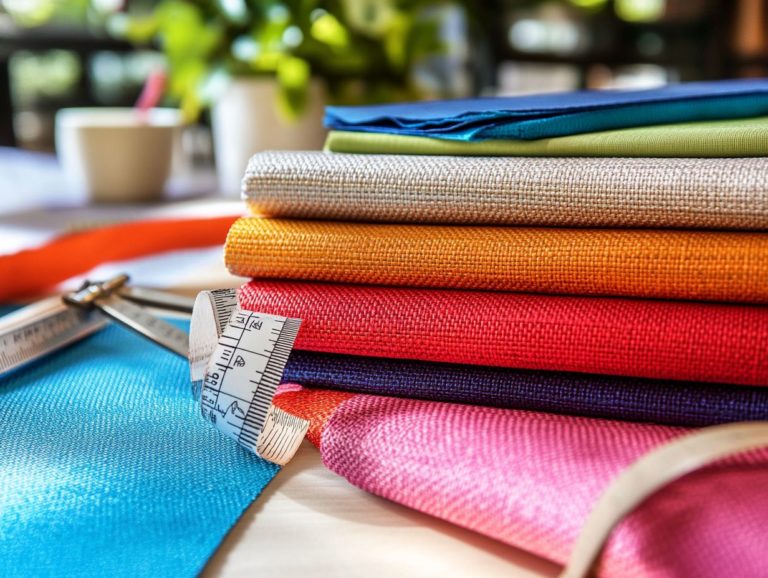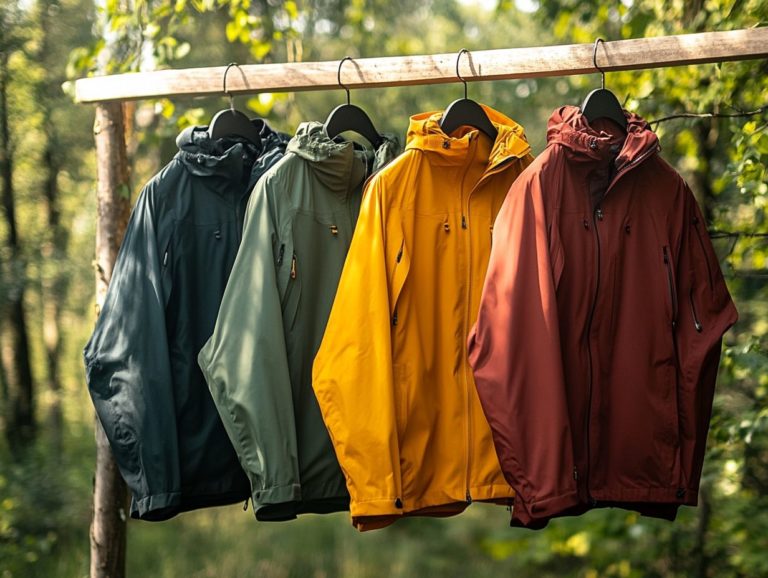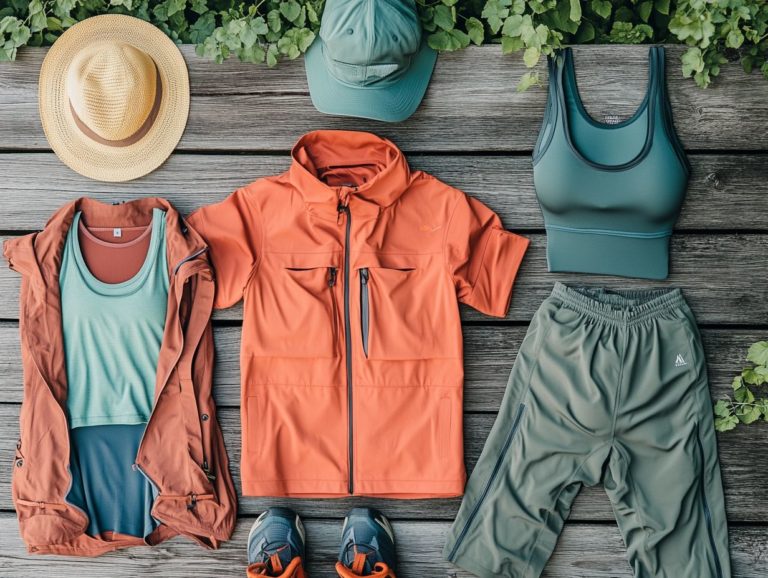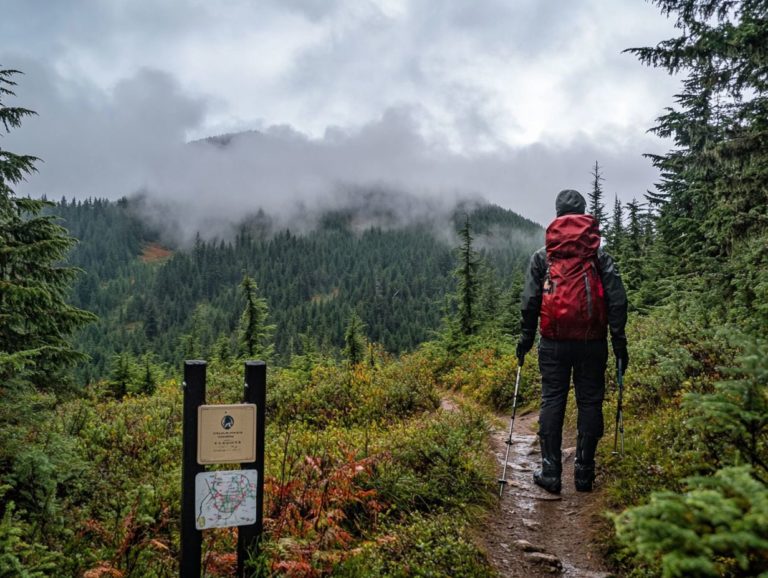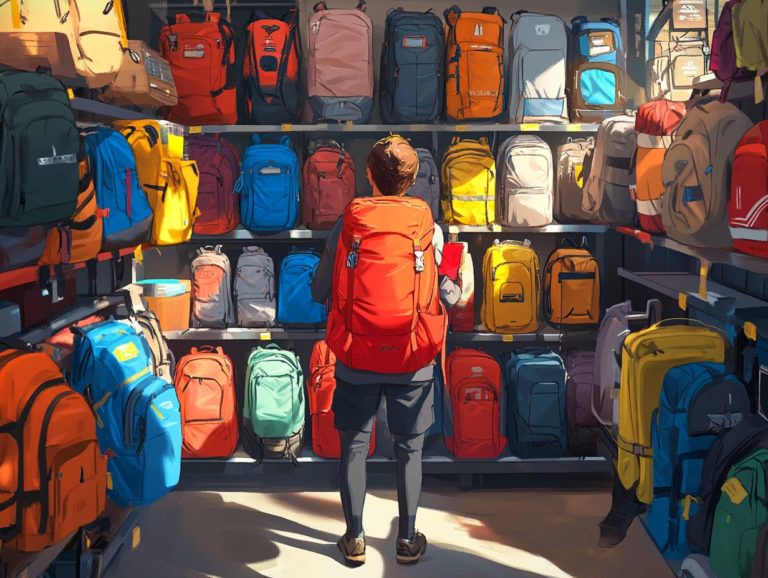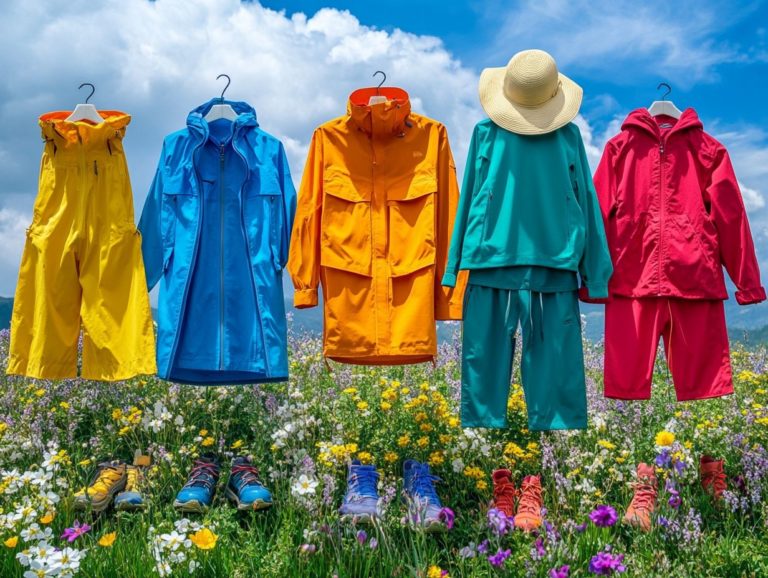Best Outdoor Clothing for Backpacking Trips
When embarking on a backpacking adventure, the clothing you choose can truly transform your experience from a mere outing into an unforgettable journey. Selecting gear that is waterproof, breathable, and comfortable is vital for fully enjoying the wonders of nature.
Get ready to explore the best outdoor clothing options for your next backpacking adventure! This guide covers everything from quick-drying pants to robust hiking boots and all the essentials in between.
Arm yourself with the insights you need to remain comfortable and protected while traversing the trails!
Contents
- Key Takeaways:
- 1. Waterproof and Breathable Jacket
- 2. Quick-Drying Hiking Pants
- 3. Moisture-Wicking Base Layers
- 4. Sturdy and Supportive Hiking Boots
- 5. Durable Backpack
- 6. Wide-Brimmed Hat
- 7. Insulated Layers for Cold Weather
- 8. Lightweight and Packable Rain Gear
- 9. Comfortable and Supportive Socks
- 10. Sun Protection Clothing
- 11. Insect Repellent Clothing
- 12. Sunglasses
- 13. Versatile and Multi-Functional Clothing
- 14. Proper Footwear for Water Activities
- 15. Layering and Packing Tips for Backpacking Clothing and Gear
- What to Consider When Choosing Outdoor Clothing for Backpacking Trips?
- Frequently Asked Questions
- What is the best type of clothing to wear on a backpacking trip?
- Should I invest in high-quality outdoor clothing for a backpacking trip?
- What should I consider when choosing outdoor clothing for a backpacking trip?
- Do I need to pack extra clothes for a backpacking trip?
- Is it necessary to wear specialized clothing for a backpacking trip?
- What should I avoid wearing on a backpacking trip?
Key Takeaways:
- Invest in a waterproof and breathable jacket for unpredictable weather. Stay dry and comfortable on the trail!
- Choose quick-drying hiking pants to keep you comfortable and avoid chafing on long trips.
- Moisture-wicking base layers are designed to pull sweat away from your skin, helping you stay dry and regulate your body temperature.
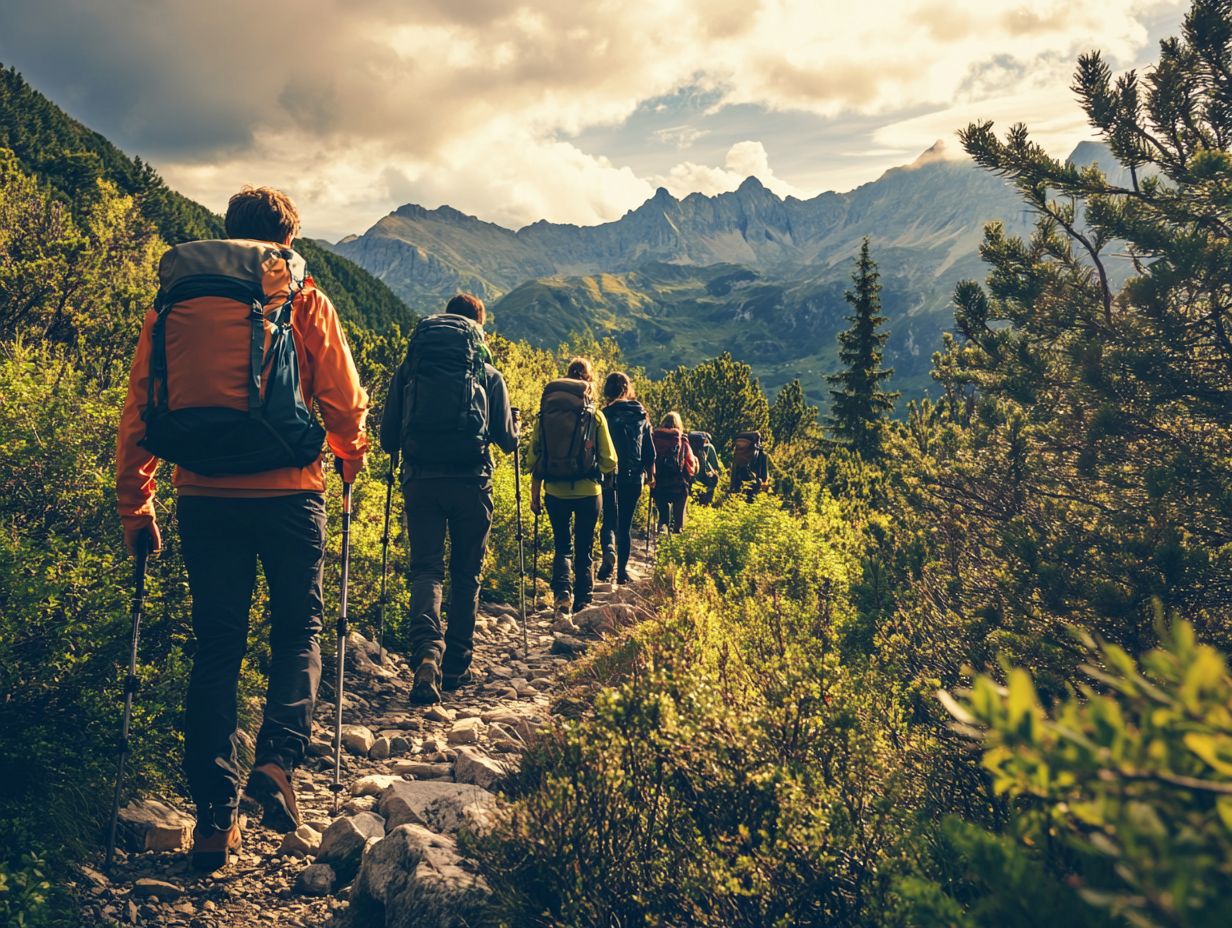
1. Waterproof and Breathable Jacket
A waterproof and breathable jacket is essential for unpredictable weather. Brands like Outdoor Research and Patagonia offer stylish options that keep you dry while managing temperature and moisture effectively.
Whether you re tackling the John Muir Trail or setting up camp in the backcountry, investing in a durable rain jacket can significantly elevate your outdoor experience. These jackets often feature advanced materials that provide protection against rain while letting sweat escape.
Features like adjustable hoods, sealed seams, and ventilated zippers add versatility in varying weather conditions. If you prioritize durability and breathability, the Patagonia Torrentshell excels during heavy downpours. The Outdoor Research Helium II is a lightweight favorite for those who value packability without sacrificing protection.
These design elements ensure your comfort and enhance your mobility, making these jackets perfect companions for all your outdoor adventures.
2. Quick-Drying Hiking Pants
Quick-drying hiking pants are essential for maintaining comfort during your outdoor activities. They help you stay dry and comfortable in unpredictable weather and varied terrains.
With advanced quick-dry fabrics, these pants are perfect whether you re tackling strenuous hikes or embarking on multi-day trips. Brands like Columbia and K HL offer a wide selection to meet your specific needs while ensuring both protection and flexibility.
For example, Columbia’s Silver Ridge series features lightweight, breathable material that offers extra protection against the sun. Meanwhile, K HL’s Rydr pants are designed for enhanced movement, catering to those who love rock scrambling or dynamic hiking experiences.
Thoughtful designs include ample pockets and adjustable waists, allowing you to carry your essentials comfortably without sacrificing style or practicality. This way, you can focus on your journey, feeling confident in your gear every step of the way!
Choose the right gear today and turn your backpacking trip into an unforgettable adventure!
3. Moisture-Wicking Base Layers
Moisture-wicking base layers are the cornerstone of a successful layering system for your outdoor wardrobe. They ensure that any perspiration is efficiently managed, keeping you comfortable during hiking and camping adventures.
By opting for materials like Merino wool and synthetic fabrics, these base layers offer excellent thermoregulation and odor resistance. This makes them suitable for a range of weather conditions and activities.
Whether you’re tackling a winter hiking trail or enjoying the mild temperatures of the shoulder seasons, investing in a quality base layer is important for enhancing your performance.
Your choice of base layer can significantly shape your outdoor experience. It directly influences heat retention and moisture control. Natural fibers, like Merino wool, shine in breathability and moisture absorption. They are perfect for colder climates where warmth is necessary.
On the other hand, synthetic options such as polyester and nylon tend to be lighter and dry more quickly. This makes them ideal for high-intensity activities or humid conditions.
When considering your options, check out these top picks for moisture-wicking base layers:
- Icebreaker s Merino wool tops for unmatched comfort.
- Patagonia s Capilene series for its durability and quick-drying features.
By understanding the differences between these materials, you can select base layers that align perfectly with your specific needs and preferences. This ultimately optimizes your performance outdoors.
4. Sturdy and Supportive Hiking Boots
Sturdy and supportive hiking boots are arguably the most crucial investment you can make in your outdoor gear. They offer the necessary protection and comfort your feet need during long hikes and challenging terrains.
Choosing the right footwear can keep your adventures injury-free and enjoyable! It also makes it a top priority on any hiking checklist.
Whether you lean towards brands like Columbia or Frogg Toggs, the ideal pair of hiking boots will boast durable fabric, effective insulation, and excellent traction tailored for various outdoor activities.
When selecting the perfect hiking boots, focus on fit first and foremost. A snug yet comfortable fit can significantly enhance your agility on the trails. The materials used in the boot s construction think breathable mesh and waterproof leather play a vital role in keeping your feet dry and comfortable, no matter the climate.
Traction is another key factor. Rugged outsoles provide the grip you need on slippery surfaces, ensuring stability during steep ascents or descents. Understanding the specific hiking conditions you plan to face will guide you toward the ideal boot, whether you’re gearing up for casual day hikes or challenging multi-day treks.
5. Durable Backpack
A durable backpack is an important part of any outdoor clothing system. It is vital for carrying your necessary gear on hiking and camping adventures.
When choosing a backpack, consider factors like capacity, weight distribution, and waterproof materials to ensure a comfortable and efficient carrying experience.
Brands like Patagonia and K HL craft backpacks that are built to endure the challenges of backcountry journeys while accommodating minimalist packing for those multi-day excursions.
These backpacks typically feature high-denier nylon, a strong, durable type of fabric, or polyester fabric, offering remarkable resistance to abrasions and tears. Construction techniques like reinforced seams and double stitching greatly enhance the product’s longevity.
Ergonomics should be at the forefront of your selection process. Cushioned shoulder straps and padded back panels minimize strain during longer treks. Effective organization is equally important, with multiple compartments and easy-access pockets that allow you to swiftly retrieve your gear.
For example, look for models that include hydration reservoirs, making it incredibly convenient to stay hydrated on the trail. For instance, the Patagonia Black Hole Pack has a great balance between capacity and comfort.
6. Wide-Brimmed Hat
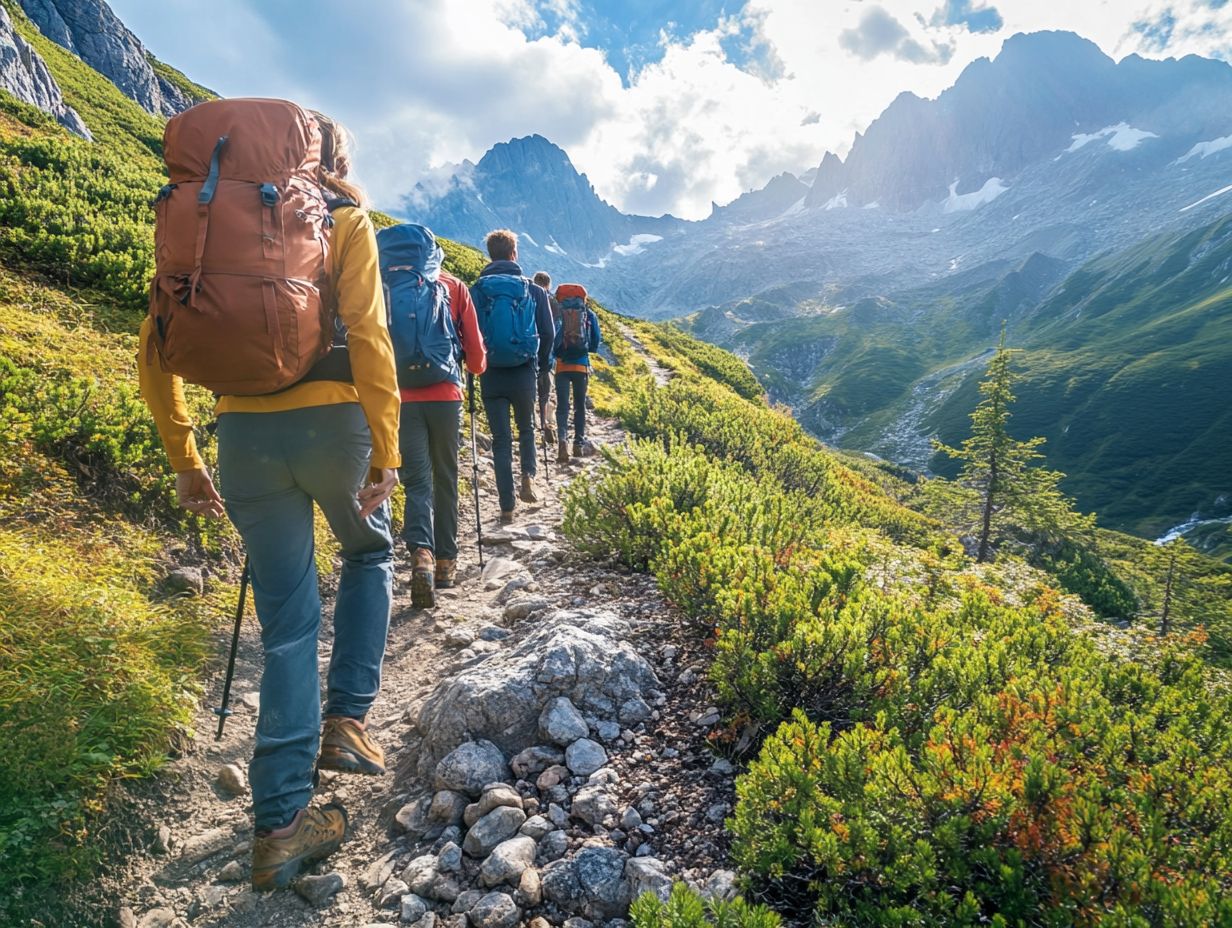
A wide-brimmed hat is essential outdoor gear. It offers sun protection and enhances comfort during your adventures.
This hat shields your face and neck from harmful UV rays. It keeps you cool and helps prevent heat-related illnesses on hot days.
Outdoor brands like Outdoor Research create stylish and functional hats. They make a great addition to your hiking wardrobe.
When picking a wide-brimmed hat, consider material, fit, and style. Look for lightweight, breathable fabrics that wick away moisture.
Styles vary from floppy hats for the beach to structured options for hiking. Features like adjustable chin straps ensure a snug fit, even on windy days.
Choosing the right hat boosts your sun protection strategy. It also adds a touch of elegance to your outdoor outfits.
7. Insulated Layers for Cold Weather
Insulated layers are crucial for staying warm during cold-weather adventures. They are vital for winter hiking and camping.
Choose high-quality options like down jackets and fleece. They provide warmth without bulk, allowing efficient layering.
Brands like Patagonia and Columbia offer insulated layers made from breathable materials. These keep moisture at bay while providing necessary insulation.
Down is known for its warmth-to-weight ratio. However, synthetic insulation is popular for its moisture-wicking abilities and heat retention, even when wet.
This versatility makes synthetic options ideal for active pursuits where sweating occurs.
For layering, combine a moisture-wicking base layer, an insulating mid-layer like fleece, and a waterproof outer shell. This creates a system to combat extreme cold.
Don t forget practical items like insulated gloves, thermal socks, and balaclavas. They significantly enhance warmth, ensuring you’re prepared for harsh conditions.
8. Lightweight and Packable Rain Gear
Lightweight and packable rain gear is essential for your outdoor wardrobe. It offers vital protection against sudden weather changes while keeping bulk to a minimum. Whether you opt for a waterproof rain jacket or rain pants, having these key items ensures you stay dry and comfortable, especially during multi-day adventures in unpredictable terrains.
Brands like Frogg Toggs excel in functionality with designs that easily tuck into small spaces, making them perfect for minimalist packing. These pieces often boast breathable materials (which allow moisture to escape) that elevate your comfort during strenuous activities. Many come equipped with adjustable hoods and cuffs for a customized fit.
Integrating rain gear into your layering system is a smart strategy. Consider wearing moisture-wicking base layers (materials that draw moisture away from the skin) underneath for enhanced comfort. This approach helps regulate your body temperature and reduces the risk of chills from perspiration.
Choosing rain jackets with ventilation zippers (zippers designed to allow airflow) boosts airflow, facilitating better moisture management during intense hikes. By carefully selecting and layering lightweight rain gear, you can confidently tackle unexpected showers without compromising your mobility.
9. Comfortable and Supportive Socks
Comfortable and supportive socks are essential for enhancing your hiking experience and maintaining foot health. When you choose moisture-wicking (materials that keep your feet dry) and quick-dry materials, you ensure your feet remain dry and blister-free an absolute must when navigating wet or challenging terrain.
Investing in high-quality hiking socks made from merino wool or other durable fabrics can further enhance comfort. Many brands specializing in outdoor gear offer lightweight socks designed to deliver both support and comfort, ensuring your feet are well-cared for throughout your adventures.
These outstanding socks often feature advanced technologies, such as strategic cushioning in key areas, providing a snug fit that adapts to the contours of your foot. This thoughtful design minimizes friction, reducing the risk of painful blisters during lengthy hikes.
Some models boast arch support and reinforced heels, solidifying a stable foundation for your journey. Investing in high-quality hiking socks will significantly elevate your overall experience on the trails, allowing you to immerse yourself in breathtaking views rather than being distracted by discomfort.
10. Sun Protection Clothing
Sun protection clothing is essential for your outdoor adventures. It shields your skin while keeping you cool in the heat.
Opt for breathable materials and UV-resistant fabrics. Brands like Columbia and Outdoor Research offer excellent options that enhance comfort and performance.
Don t forget a sun hat! It adds extra protection against harmful rays.
This clothing often features UPF (Ultraviolet Protection Factor) ratings. For instance, a wide-brimmed sun hat with a UPF 50 rating provides fantastic coverage.
Many shirts come with materials that keep you dry and regulate your body temperature. Choose lightweight, long-sleeve shirts for sunny hikes or fishing trips.
Some brands even add zippered ventilation for better airflow. With these protective features, you can enjoy your activities with confidence!
11. Insect Repellent Clothing
Discover how insect repellent clothing can keep you comfortable on your outdoor adventures. This type of clothing offers vital bug protection, allowing you to enjoy nature without discomfort.
Crafted with specialized materials that repel mosquitoes and other biting insects, these garments help you avoid allergic reactions on camping trips and hikes. Look for options that blend insect-repellent technologies into breathable fabrics.
These technologies often use permethrin, a strong insect repellent that bonds with fabric fibers. This means it stays effective even after multiple washes.
When selecting your garments, aim for a balance between durability and flexibility. Lightweight materials that wick away moisture can improve your comfort during warm weather.
Always check for certification labels indicating the level of insect protection. Also, ensure the fit allows for easy movement, whether you’re hiking up a trail or relaxing by a campfire.
Don t leave for your next adventure without the right insect repellent clothing! By choosing wisely, you can enjoy the great outdoors without worrying about pesky insect bites.
12. Sunglasses
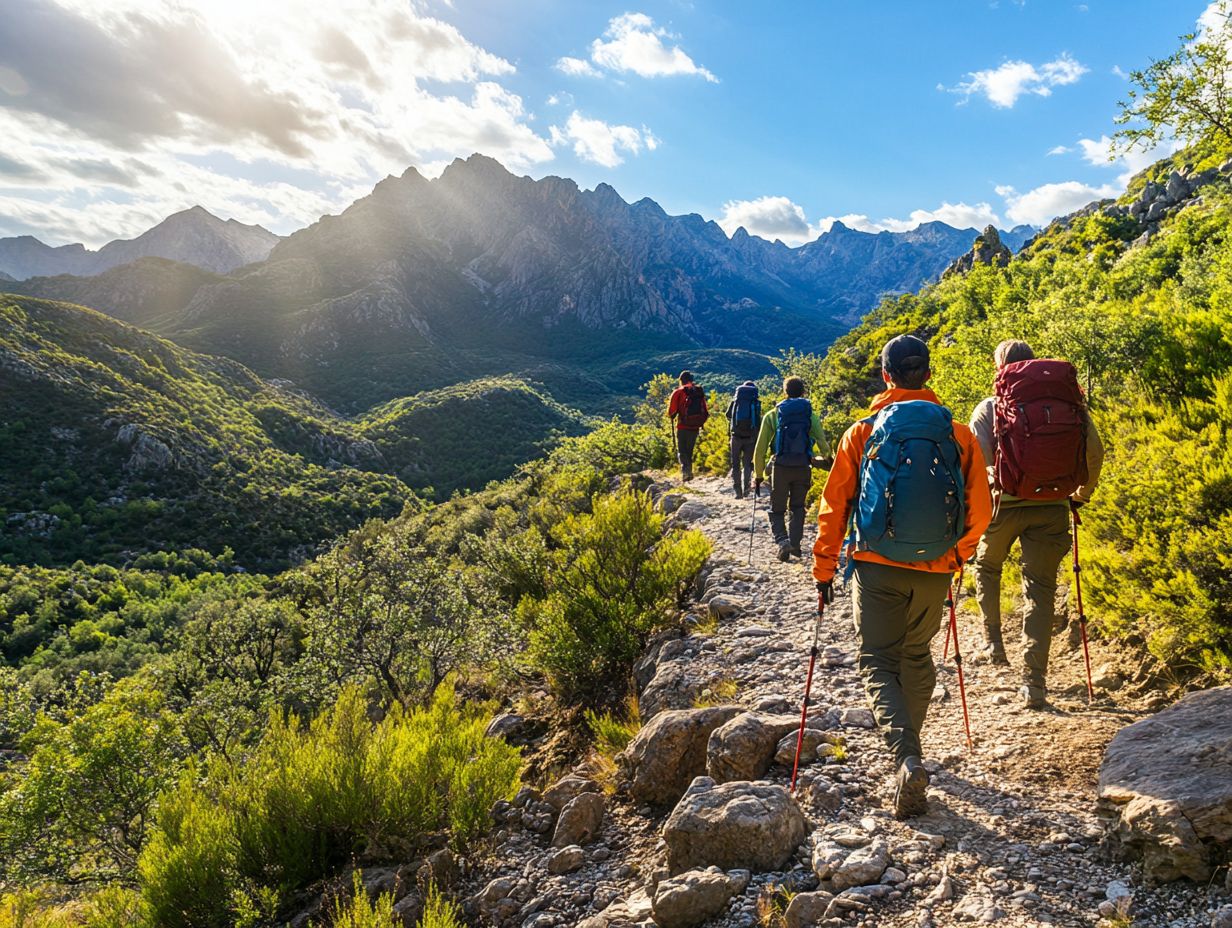
Sunglasses are a must-have for outdoor activities. They protect your eyes during hiking, camping, and other adventures.
Look for sunglasses that block harmful UV rays and reduce glare. High-quality options ensure your comfort and safety in bright conditions.
If you enjoy water sports, choose polarized lenses for better visibility on reflective surfaces.
Brands like Ray-Ban, Oakley, and Maui Jim offer stylish options that fit comfortably and protect your eyes. Make sure they fit snugly for an unobstructed view.
13. Versatile and Multi-Functional Clothing
Versatile clothing is key for outdoor activities. It helps you adapt to different weather conditions without hassle.
Look for items like zip-off pants and convertible jackets. These clothes make your outdoor adventures more comfortable and easy.
Breathable base layers keep you comfortable from a chilly morning to a warm afternoon. Moisture-wicking fabrics draw sweat away to keep you dry.
This adaptability simplifies packing and invites spontaneity. Choose items like multi-pocketed vests and lightweight fleece pullovers for an enjoyable experience in nature.
14. Proper Footwear for Water Activities
Proper footwear is essential for your safety and comfort during activities like kayaking, hiking around lakes, or crossing rivers. Choose the right shoes like camp shoes or trail running shoes with quick-dry features to elevate your experience!
Look for footwear made from durable fabric that can handle various environments. Brands specialize in crafting shoes for water activities, ensuring you feel secure and comfortable on any terrain.
When exploring options, prioritize features like a reliable grip to avoid accidents. Don t wait ensure your shoes have effective drainage systems that allow water to flow out easily this helps them dry quickly.
Consider sandals with robust straps and contoured soles, perfect for wading through streams or enjoying a beach day. Focusing on these key features makes choosing the right pair a breeze.
15. Layering and Packing Tips for Backpacking Clothing and Gear
Layering and packing tips are vital for efficient outdoor clothing systems, especially during backpacking trips where space is limited. Use layering techniques that combine base layers, insulating layers, and waterproof gear to adapt to changing weather easily.
Pack thoughtfully! Minimalist packing optimizes your gear selection, preparing you for any adventure, whether it’s a day hike or a longer trek.
Mixing and matching layers enhances adaptability. Lightweight merino wool base layers wick moisture while keeping you warm. Synthetic insulating layers retain heat even when wet perfect for unpredictable climates!
For your outermost layer, a breathable rain jacket shields you from rain and wind without causing overheating. Roll your clothes instead of folding them to save space, and utilize packing cubes to keep your gear organized and accessible.
What to Consider When Choosing Outdoor Clothing for Backpacking Trips?
When selecting outdoor clothing for your backpacking trips, there are several essential factors to consider. This ensures you remain comfortable, protected, and efficient in your backcountry outfits on the trail. Aim for clothing systems that emphasize how well the clothing handles sweat, insulation, and weatherproofing, allowing you to adapt to varying conditions effortlessly.
Key items like lightweight rain jackets, durable backpacks, and versatile clothing such as hiking shorts and quick-dry underwear will significantly elevate your experience. For a comprehensive list of what to bring, check out this essential gear for a successful backpacking trip. They grant you the adaptability needed as you traverse diverse landscapes.
It’s also important to assess the specific climate and activities you anticipate during your journey. For instance, if you’re hiking in colder regions, base layers that keep you warm and insulated jackets will be your best allies for warmth. Conversely, when navigating hotter climates, moisture-wicking shirts and breathable shorts will help keep you cool and comfortable.
Your personal preferences also play a vital role in your choices. Some may prefer synthetic materials for their quick-drying capabilities, while others might lean towards natural fibers for their comfort. Thoughtfully selecting options like layered clothing allows for easy adjustments as conditions shift. Additionally, having the best survival gear for backpackers sets you up for a fantastic backpacking adventure!
Frequently Asked Questions
What is the best type of clothing to wear on a backpacking trip?
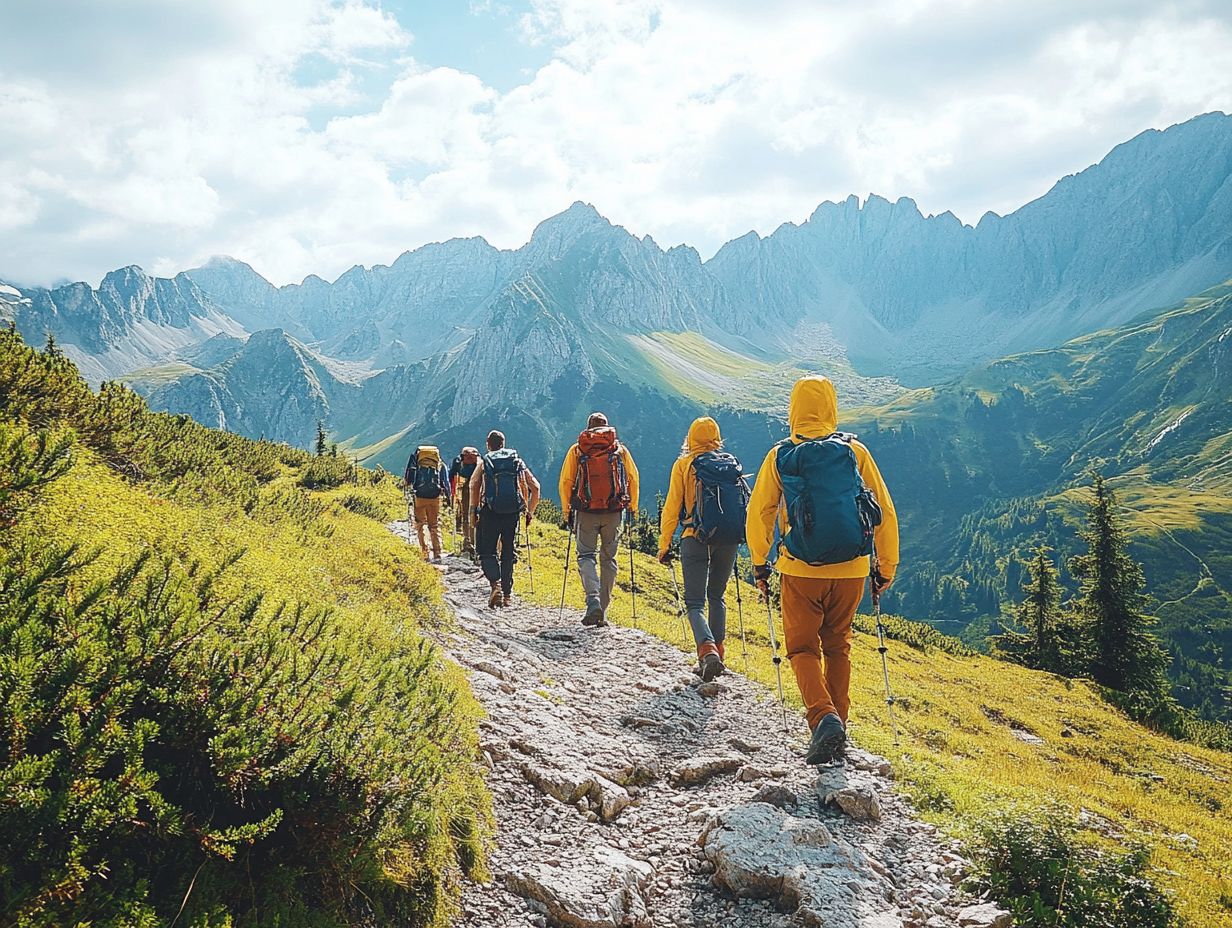
The best outdoor clothing for backpacking trips is durable, lightweight, and moisture-wicking. This includes hiking pants, moisture-wicking base layers, and a waterproof jacket, such as a rain jacket.
Should I invest in high-quality outdoor clothing for a backpacking trip?
Yes, investing in high-quality outdoor clothing, like those from brands such as Patagonia or Outdoor Research, is essential for a comfortable and safe backpacking trip. Cheap clothing may not withstand the elements and can lead to discomfort or even injury.
What should I consider when choosing outdoor clothing for a backpacking trip?
When choosing clothing for a backpacking trip, consider the weather, terrain, and the length of your trip. Opt for moisture-wicking and quick-drying materials, such as quick-dry fabrics and odor resistant options. Choose layers that can be easily added or removed.
Do I need to pack extra clothes for a backpacking trip?
It is recommended to pack extra clothes, including warm hats and quick-dry underwear, for a backpacking trip, especially for longer trips. You may encounter unexpected weather changes or need to change into clean clothes after a day of hiking.
Is it necessary to wear specialized clothing for a backpacking trip?
While not necessary, wearing specialized outdoor clothing, such as trail running shoes or hiking boots, for a backpacking trip can greatly improve your experience. These clothes are designed specifically for outdoor activities and can provide protection and comfort in various conditions.
What should I avoid wearing on a backpacking trip?
Avoid wearing cotton clothing on a backpacking trip, as it retains moisture and can lead to discomfort or hypothermia. It is also best to avoid tight or uncomfortable clothing, such as those made from durable fabric, that can hinder movement or cause chafing.

